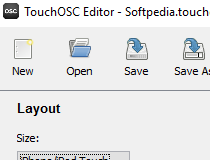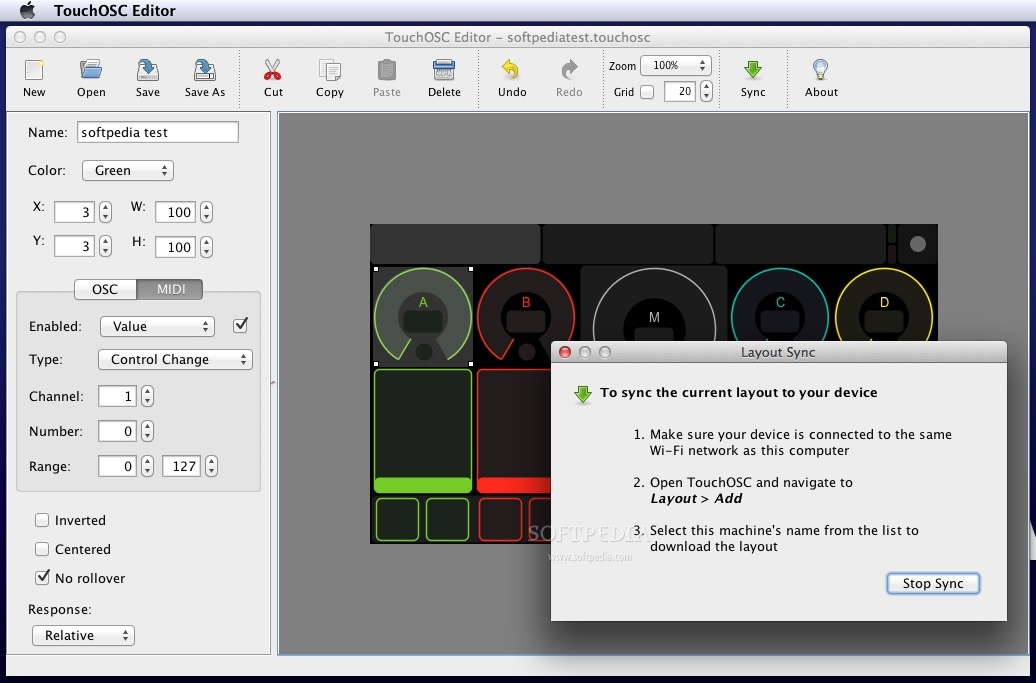Mixbus is a full-featured digital audio workstation (DAW) for recording, editing, mixing, and mastering your music and comes with 19 built-in plugins!
The long awaited follow up to the TouchOSC Ableton Live controller template LiveControl. Built on Lemur technology, featuring simplified connection, and optimised layout. LiveControl 2 brings a huge number of new features. The version of TouchOSC Editor para Mac you are about to download is 1.8.9. The download was scanned for viruses by our system. We also recommend you check the files before installation. TouchOSC Editor is distributed free of charge. The contents of the download are original and were not modified in any way.
Editor-in-chief at CreativeApplications.Net, co-founder and editorial director at HOLO Magazine, director of platform at FRM and researcher/lecturer at the University of Westminster, London. One of the first and most popular apps on iOS for remotely controlling the visuals running on your Mac is TouchOSC from Hexler which allows for customizing which controls are accessible from your iPhone, iPad, or iPod Touch, and configure their layout. Download TouchOSC and enjoy it on your iPhone, iPad, and iPod touch. TouchOSC is a modular OSC and MIDI control surface for iPhone, iPod Touch and iPad by hexler. It supports sending and receiving Open Sound Control and MIDI messages over Wi-Fi and CoreMIDI inter.
'Within the first 5 seconds I knew! ...It was big, it was phat, it was round, it was analog. It had an analog feel to it and you could tell immediately!'
- Bobby Owsinski (credits: Jimi Hendrix, The Who, Pantera, Willie Nelson, Elvis, Neil Young, Iron Maiden, The Ramones, and Chicago)With dozens of DAWs to choose from, there's only one that is designed to work like a Harrison—with an analog paradigm that embodies form, function, and sound. Where other DAWs use a computer paradigm, MIXBUS grows from Harrison's distinguished 40-year heritage of platinum records and blockbuster films such as Thriller, Graceland, and Spider-Man. Mixbus is the first full-featured DAW with true analog-style mixing.
Harrison has a unique history. In the mid-80s, we developed fully-automated, digitally-controlled analog mixer technology which was adopted by premiere film-mixing facilities around the world. When the digital revolution came, we were asked to convert the analog 'processor' into a digital processor, while leaving the control surface unchanged. Film mixers wanted the control surface to work and sound exactly like the analog mixer they were using for previous projects. This required us to develop a digital audio engine that operated and sounded exactly like the analog mixer they were using for previous projects. This transition was not undertaken by any other company, and it has provided us with techniques and proprietary technology that we have incorporated into all of our high-end mixers. Mixbus gives us an opportunity to share this technology with a much wider range of users.
Other DAWs are designed by companies with experience in computer sound, but no pedigree in world-class recording facilities. The Mixbus DSP mixer is designed by Harrison specifically for its great-sounding EQ, filters, dynamics, and bus summing. If you find a music recording from the golden age of albums—the 70s and 80s—that has stood the test of time, a Harrison console was likely used during production. Mixbus invites you to produce recordings that will stand with the very best.

Mixbus works on the three most popular desktop operating systems (Mac OS X, Windows, and Linux) in both 32 bit and 64 bit versions, and loads industry standard I/O and plug-in formats (VST, VST3, AU, & LV2). Do you collaborate with other Mixbus users? A session from a collaborator using Harrison plug-ins will playback in your Mixbus as originally recorded including full performance of all the plug-in information even if you have not purchased those specific Harrison plug-ins yourself. Sessions can be shared among Windows, Mac, and Linux users.
Mixbus provides professional-level features to import or record an unlimited number of audio or MIDI tracks to your computer; then edit, mix, and master your production.


- Straightforward 'knob per function' mixer layout based on Harrison's renowned music consoles
- Precision algorithms for EQ, Filter, Compression, Analog Tape Saturation, and Summing
- The Mixbus engine is internally dithered, ramped, and gain staged so that sound quality is preserved as close to analog as possible
- Unlimited stereo or mono input channels, each with unlimited plug-ins, sends, and hardware inserts (limited only by CPU and disc speed)
- Unlimited MIDI tracks, each with virtual instrument support, unlimited plug-ins, sends and inserts
- Polarity, Input trim, High-pass Filter, Sweepable 3-band EQ, Compression, and 8 Mix Bus sends on every track
- Stereo Master Bus that features Tone Controls, Analog Tape Saturation, K-meter, Stereo Correlation Meter, and Limiter
- Automatic plug-in delay compensation to support effects such as parallel compression without time misalignment
- Comprehensive 'at-a-glance' metering with peak, peak hold, and compressor gain reduction visible on every track and bus
- Extensive DAW editing features including 'Smart Tool', Ripple Edit, and configurable keybindings for nearly every operation
- Industry standard plug-in support: Mixbus loads AudioUnit (AU) plug-ins on OSX; and VST3, VST and LV2 plug-ins on all platforms
- Mixbus provides professional features such as Loudness Analysis (dBTP+LUFS+LU Range), LTC (SMPTE) generation and sync; video pullup/pulldown
- Persistent undo (undo remains possible after closing and reopening a session)
- Fourth-generation Harrison 'True Analog Mixing™' processing engine with enhanced compressor/limiter algorithms, built-in sidechain bussing, and increased plug-in flexibility
- Support for video timeline, video window, and audio+video exports
- Recording operates like a tape machine: Punch-in on the fly, and use per-track input monitoring just like a multitrack tape machine
- Extensive export features including multitrack stem export, simultaneous multi-format exports, multiple export ranges, CD track markers, silence trimming, normalization, and command-line arguments to trigger third-party encoders or file-management scripts
- Audio regions are stacked in 'layers', and every region fadein/out is a crossfade to the region(s) beneath it
- Plugin 'pin connection management' provides rich editing of signal-flow through each channel's path, including full support for dual mono, mono-to-stereo, sidechaining, and other advanced flows
- The user interface scales to fit your monitor—larger monitors will get bigger knobs and sharper text
- Refined workflow and graphics, including scaling and support for HiDPI (Retina) displays
- Generic MIDI devices can use 'MIDI Learn' to assign MIDI controls directly to on-screen knobs or use MIDI profiles to select many pre-configured device layouts from a pull-down menu
- Mackie control protocol is provided for motorized fader controllers, and the Mackie protocols have been extended to ergonomically control the Mixbus channelstrip EQ, compressor, and 8 mixbus sends. Dedicated support is provided for popular devices like the Presonus Faderport, Mackie MCU, and Behringer X-Touch controllers
- OSC (Open Sound Control) protocol supports ethernet-based wireless tablet controllers such as TouchOSC and Lemur for iOS and Android to remote-control Mixbus
- Lua Scripting: Use the Lua scripting language to automate tasks such as track creation, renaming tracks, adding plugins, or creating 'macro' operations
- VCA Faders: Use VCA faders to control multiple channel faders at once—a fader can be assigned to multiple remote VCA faders, adding another powerful dimension of control and organization to your mixes
- Tempo Ramps and Tempo Maps: Use advanced features to map your live recording's tempo and structure (no need to record to a click!)—or import a tempo map from MIDI
- New 5th-generation audio engine with smoother operation, better looping, and extensive latency compensation through more DAW-style bussing and sidechain paths
- Cue-monitoring: MIDI tracks now monitor both the input and playback simultaneously, by default
- DAW-style 'Aux' buses are now integrated in the Mixbus engine, with latency compensation and pans that can follow the main track panner, or not
- Foldback buses allow the building of unlimited custom cue mixes for artists
- A new Cut Tool is dedicated to splitting regions in addition to the existing keyboard shortcuts
- Source List: Organize your recordings by Take ID, so you can locate and recover that great take from yesterday's session
- Virtual MIDI Keyboard: enter rhythms and melodies with your QWERTY keyboard, with controller and transposition featuresNative MP3 import & export on all platforms (Mac, Windows and Linux)
Mixbus Resources
Related Products
TouchOSC is a modular OSC and MIDI control surface for iOS (iPhone/iPod Touch/iPad) and Android. It can send TouchDesigner messages via OSC from interactions with its control panels. Custom control panels can be created by using the TouchOSC Editor which is available for Windows/Mac OSX/Linux.

Additional information and links to the App Store and the TouchOSC Editor can be found here: http://hexler.net/software/touchosc
Using TouchOSC with TouchDesigner[edit]
Setting up TouchOSC[edit]
First make sure that the device running TouchOSC and the computer running TouchDesigner are on the same wireless network so they can communicate with each other.
After installing TouchOSC, launch the app and you will see the following screen.
Open the OSC:Disabled menu. Once on this next page, turn on the Enabled switch to reveal the following screen.
On this settings screen, input the IP address of your computer running TouchDesigner. If you do not want to use the default port numbers, change them here as well. Once completed, press the Done button to close the dialog.
Back at the start screen for TouchOSC, select the Layout you would like to use from the Layout menu. When ready, press the Done button.
Setting up TouchDesigner[edit]
Open TouchDesigner and create a OSC In CHOP or OSC In DAT. Change the Network Port parameter to be the same port you select in TouchOSC's Port(outgoing) setting. Default is 8000.
Touchosc Editor Mac Download
Now move or adjust any control in TouchOSC, you will see the incoming values in TouchDesigner.
Touchosc Windows 10

